Not all homeschools are created equal. We all do things differently, so we all need our individual homeschool plan to accomplish our year.
You may know you need a plan. You may not understand how a plan can be helpful. But we’ll tackle both of those today.
Cause we as homeschool moms have to do all the things! It’s a lot. So today we will talk about how to create a flexible plan to get your homeschool chaos all in order. A plan that is customized for you and your own kids.
A plan that works for you!
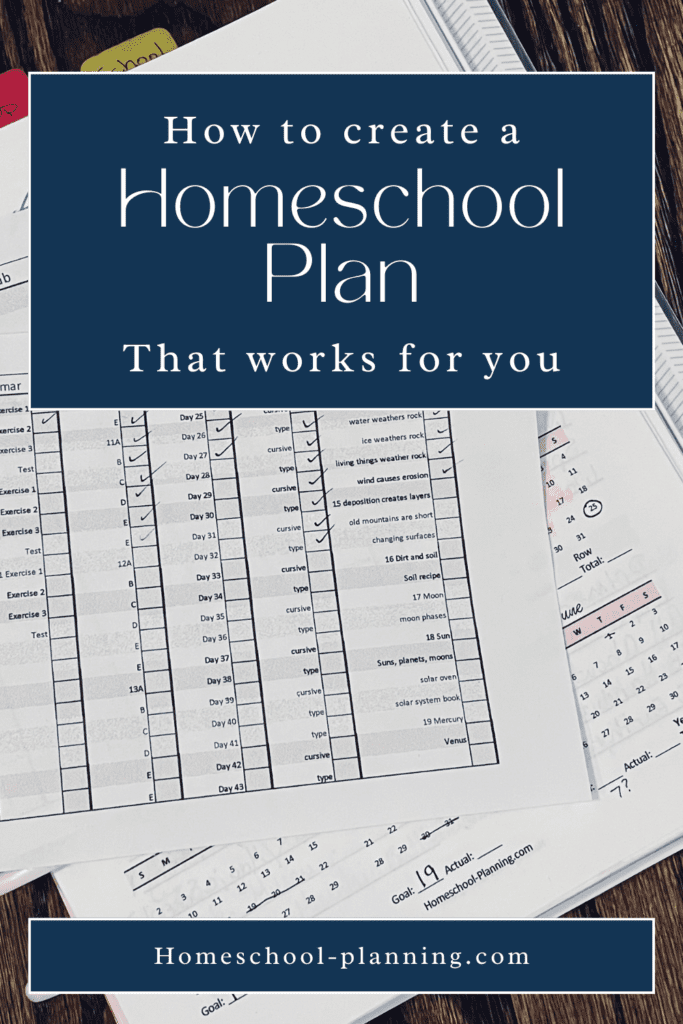
What do I plan?
A homeschool plan for your year will be what you refer to day by day as you go through your year ahead.
When planning, you will work from a large overarching view of your year and resources and break it all down to smaller chunks of work, even to daily assignments if desired.
You will decide how to approach your days with your resources and schedules. A complete plan will also include all the paperwork done after the work is completed, from tracking on the daily to grade reporting at the end.
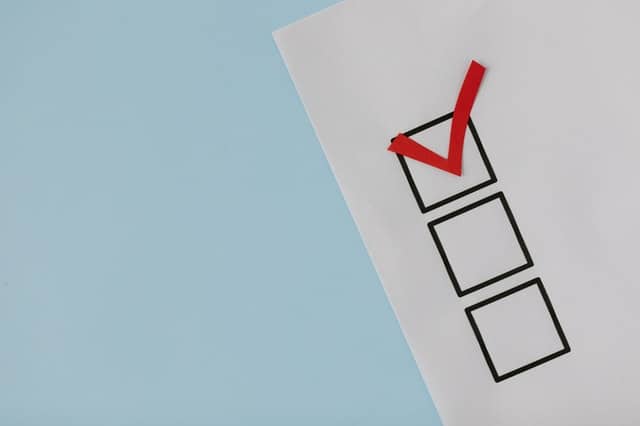
Why do I even need a homeschool plan?
Homeschool plans help streamline your days. They help reduce overwhelm and take care of your future self. As homeschool parents, we have so much to do and having a plan in place helps you organize the chaos of your homeschool so you have time to focus on your kids.
1. Homeschool plans help streamline your days
Planning in advance give you a guide for your days. You get more done when you know what’s coming next.
If you don’t have a plan, you can end up floundering. You waste time figuring out what comes next. Finding supplies. Making sure you’re on track.
Having a homeschool plan isn’t so you can fit more into your day. It’s so you can do the day you have on your heart.
And it shouldn’t be a plan that makes you feel trapped.
It won’t look like anyone else’s day and that’s a good thing. It won’t remove the doubts that you’re doing it all right, but it will help you focus more on the most important part of homeschooling everyday – your kids.
If you aim at nothing, you’ll hit it every time.
Zig Zigler
2. Homeschool plans reduce overwhelm
All the chaos of various books, ideas, and paperwork along with each child and what is wanted, needed and required of each can lead to overwhelming days when you’re already doing all the other things of life.
Planning more in advance will help free up more time during your week so you can deal with more of the day to day stresses of life.
When my third child was a toddler, my other two were 5 and 8. I was not only chasing a 1 year old around, but also trying to figure out how to do a school day with a kindergartner and third grader.
Balancing the reading aloud, math books, cooking, naps, cleaning, nursing sessions, and science experiments were often more than I could handle in one day. I definitely had to come up with a bit of a plan for all the times when my hands and thoughts were overwhelmed.
Our history lessons used lots of documentaries and audiobooks to free up my time and add some fun. Our time with workbooks was pretty short and we went to the playground a lot.
School looks much different for us now that they’re older. And yours will be different too.
Each season of life has its own challenges.
By Failing to prepare, you are preparing to fail.”
Benjamin Franklin
3. Homeschool plans take care of your future self
Moms have trouble taking care of themselves. It’s the truth. Being a mom is a full-time job. And when everything and everyone around you is demanding your attention, taking care of yourself is often the last thing on our minds.
After months of this, you end up burning out.
Homeschool moms especially have trouble with this. Cause now we have at least 2 full-time jobs. Mom. Teacher.
Then throw in all the other tasks – cooking, cleaning, driver, secretary….
So take care of your future self and make a plan for all the things you do. Especially the actual teaching.
Then there’s no more questioning what needs to be done each day. It’s already set.
No decision fatigue. You’ve done it already.
When you’re having a bad day, there’s no more added stress of lesson planning. If something unexpected happens, you can delay school and know right where to pick it up again.

The Homeschool Plan
I’ve broken down my homeschool planning process for you here. It won’t be fast or easy. For a simple and fast plan, head on over to my other post here.
My detailed planning process can be a big undertaking and quite mentally draining. I’ll be honest, I spend days planning my homeschool year.
But don’t let that scare you. I can be a little obsessive – mostly over curriculum. Ha!
So I encourage you to grab a coffee, a note book for brainstorming, and a couple free hours here and there. Grab my free planning pages to give you a frame work.
Over the next few days we’ll work our way through together.
I believe you were led to homeschooling for a reason and what you have for your children is exactly what they need. You can do this.
I’ve created a small bundle of free planning pages to help you get started!
Ready to get started? Let’s get to it!

Stage 1: Homeschool pre-planning
In the pre-planning stage, we think through where we’ve been and where we’re going. You can’t make a homeschool plan if you don’t know where you are.
Download my free goal setting and pre-planning worksheets to help you work through this stage.
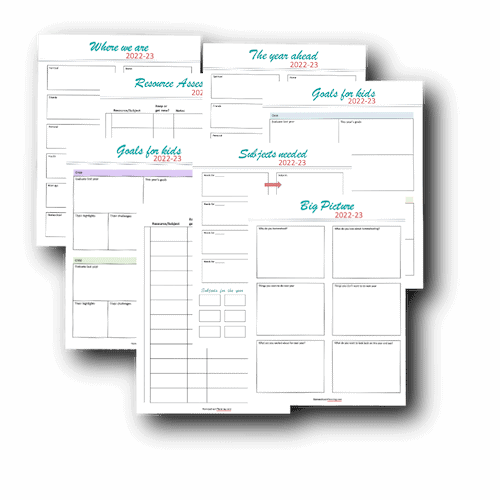
1. Evaluate your homeschool
The first step in creating a homeschool plan for anything requires figuring out where things currently stand in any given area.
So before you can decide what you are looking to accomplish this school year, you have to evaluate what you have already accomplished and what does and doesn’t work.
Think of this as a brain dump of the past year. Just write it out.
What has been going well in your home over the past few months? What areas do you feel need some extra attention? Take a look at the big picture of your family and try to work out where things are at in every area, not just with school.
Here are some categories you may want to think over:
- Schoolwork
- Relationships
- Character
- Structure
- Discipline
- Chores
- Work
- Health
- Financials
- Anything else that God puts on your heart.
Write these thoughts down as a starting point.
Next, look at the school resources you have been using and evaluate those as well.
Is your child struggling with their math book but really excelling in spelling? Do you just cringe every time you glance at the science book but absolutely love reading aloud to your kids?
Write down all these thoughts – good and bad. Write what you like, don’t like, what area needs work, what areas you might want to get some input on.
Be honest here and take your time. You may be surprised where this leads you.
If you want some guidance for this step, download my free homeschool evaluation printables.

2. Create homeschool goals
Now that you have cleared all the clutter of the past few months, use those thoughts as a starting point for looking at your next year. Create some goals for your homeschool and life in general. This is the next step in the process of creating your homeschool plan.
Start with a high-level view and create a general idea of where you hope to be at the end of that time.
Perhaps the large picture is a little too overwhelming for you. That’s ok, maybe you need to do a general vision for each of those parts of life you evaluated rather than one big vision. That is up to you.
Or possibly you like the general and could create an overarching mission for your year to frame out everything else. Don’t get stuck on making this fancy or amazing, just list out what you want for your family in a few general ways.
With this high-level vision set, now it is time to break that down into smaller actionable goals.
Be precise here and practical but you don’t have to know all the specifics yet.
Take each of those categories and resources you looked at in step one and view it through your overarching vision. See where this takes you.
The things you felt needed changing, how will you go about that? These goals could be for the whole school year, next semester, first quarter, or even just a month. Whatever time frame you set, you need to know what you generally want to accomplish by the end of that time.
For instance, perhaps your vision for the year includes more intentional time together as a family, more outdoors time and less screens.
Since you already don’t like your science curriculum, maybe you could choose a goal of finding and using an earth and nature science curriculum with lots of hiking to supplement.
You can flesh out the specifics in a bit.
If you need to get better at cleaning the house, you could possibly work on that family time and decide you will set up a family cleaning time each day. See how these more actionable goals can fit into your broader visions?
I’ve made some great resources to help you through this goal setting step! Click here to download some free printables to help you with goal setting in your homeschool.
Simplicity is about subtracting the obvious and adding the meaningful.
John Maeda
Stage 2: Homeschool curriculum
When it comes to homeschooling, most parents use homeschool curriculum. If you don’t use curriculum, you will likely at least use some sort of resources.
This can include books, classes, places to visit and various other things.
In stage 2 of the homeschool planning process, we decide on the subjects to teach and what curriculum and resources we use.
Read: The Ultimate Guide to Choosing Homeschool Curriculum
Download my free choosing currciulum worksheets to help you through this step.
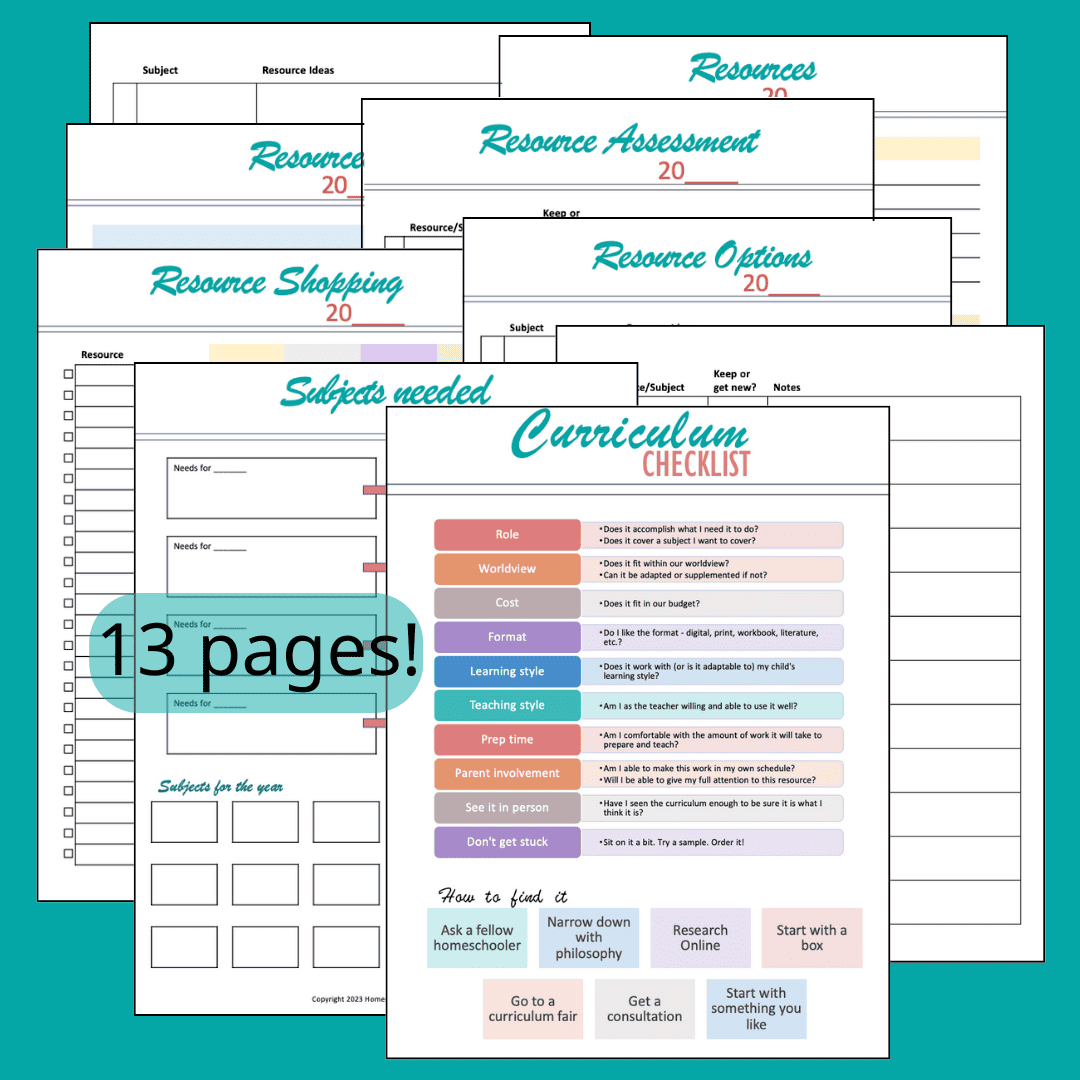
3. Choose homeschool subjects
This step in the homeschool plan process will help you start to get a little more specific with those goals you’ve been working on. We’re going to narrow down what subjects we want to do this year.
When you were thinking about your past few months, was there a goal you decided to work on that needs specific attention?
Cooking with your children for instance, or maybe you want to be sure your kids know how to type this year.
Perhaps you noticed that you want to work on encouraging good character in your children. You could do this in multiple ways. Through a curriculum on character building, a bible study, or in more general ways like more family time and intentional outings.
This step is where you decide what goals need to be a specific subject with a specific resource and which you will work on in other ways.
Of course most homeschoolers will be including the five general subjects of reading, writing, math, science, and history. Some US state laws even require you cover these subjects.
It’s totally alright to only do those, and some years and seasons of life it may be all you can handle. Other years you may feel the need to do more than that or go really heavy in one of those subjects.
Work all that out now. And yes, write it down!
I’ve made a great worksheet to walk you through this step. It’s included in the free goal setting and pre-planning printables download.
“Make a bad plan. Make the best one you can but don’t get obsessive about it. Make a plan, implement it. You’ll figure out when you implement it why it’s stupid exactly, and then you can fix it a little bit, and then you can fix it a bit more, then you can fix it a bit more and then eventually you get a good plan even if you start with something that’s not good.”
Jordan B. Peterson
4. Find homeschool curriculum
Alright, the goals are set and you know what subjects you want to accomplish. The next step in your homeschool plan is to find homeschool curriculum, tools and resources to help you accomplish all that.
You can go down so many rabbit holes including the huge amount of curriculum options, researching extra-curriculurs, book lists, and pursuing possible co-op involvement. It also may be a good time to find a good planner option that works for you if you haven’t already.
Read these posts to find the best paper homeschool planners and homeschool planners you can use on a computer.
This step may likely take quite a bit of time since there are so many options out there!
I usually start out with my list of general subjects I want to do (step 3) then I find several options for each subject.
I do a lot of online research, ask other homeschoolers I know for ideas, read lots of reviews, download samples online, and go to curriculum fairs to see them in person.
For more on this, check out my post on where to find homeschool curriculum.
Through all of this I can usually narrow the options down until I feel like each subject has a good resource chosen or plan of attack.
There are a lot of things to consider when choosing resources for your family that I won’t go into here. You can read more about my tips for choosing curriculum here.
A few of those things to think about are:
- Cost
- Format (digital, print, etc.)
- Learning style of your child
- Your teaching style
- Prep time
- Parent involvement required
- Will it fill the role you need it to fill?
Ultimately, it may look amazing, but will you use it and will it help your child learn?
Keep in mind that sometimes a resource won’t be a specific “curriculum”. For instance in cooking, maybe the resource is you!
So if you decide to design your own approach to teaching a subject, this is a good time to get a general idea of how that will go.
You may want to search for a book or two to inspire you or to guide the learning process. Or maybe you’ll want to jot down a list of topics you’ll want to cover. Whatever general planning you can get down now will help you in the long run.
I like to get things narrowed down, then I do something crazy.
I sit on my decision for a bit.
Pray about it. Sometimes a few days, sometimes it’s weeks. This helps me to not overanalyze things too much.
I want to be sure I am not drawn to the resource because it’s fancy and shiny and my friend told me it’s perfect for me. Or because everyone else is using it. Because honestly only time will tell whether it will work for my family or not.
If I won’t use it, it’s worthless.
Usually after I’ve spent some time away from the pressure of finding the “right thing” I am able to come back to it with a clear head and peace about my decision. If there is not peace, then I keep looking. If there is peace, then I order it.
To help you through finding curriculum, I have created some free curriculum planning worksheets for you!
Read: Where to buy homeschool curriculum

What we use
If you’re interested to know what curriculum my family uses, I’ve created some blog posts with just that info. Follow the links below. It takes a while to create these posts, but more are coming! So keep checking back.
Homeschooling a preschooler
Kindergarten Curriculum for Homeschooling

Stage 3: Homeschool planning
Stage 3 of my planning process is the nitty gritty homeschool planning. This is the most intensive part in my opinion. I recommend you set aside a good chunk or two of time for this part.
To help you through this stage, I have created a basic free bundle of printable homeschool planning worksheets. This includes pages for attendance planning, scheduling, morning time, and even book lists! These will be a great help in creating your homeschool plan!

5. Homeschool Attendance planning
Next step in your homeschool plan is homeschool attendance planning. Now some of you may be thinking that tracking attendance is an unnecessary step. For some it is.
It’s true, life is our school and kids are always learning. Putting school into a box of a certain number of days can limit the learning for some. But it really doesn’t have to. This is just administrative.
There doesn’t have to be a view of “doing school” on one part your day while “not doing school” in another part.
If you’re chill like that, skip this part. But for planner types like me, let’s do this. Also keep in mind that some states actually require records including a certain number of reported school days, so tracking this is a necessary step for many.
So this is a good time to look over your state laws and consider how that will fit into your year.
- What will your overall year look like time wise? Does your state require you school for 180 days? Or maybe it’s less.
- Will you follow your local school system’s schedule for holidays and start days or will you do your own thing?
- Do you have other things like co-ops that need to fit into your weekly schedule?
This is a good time to pencil down – yes I said pencil – how many days each month you plan on doing more formal school and generally when you’ll take breaks.
I actually print or write out a calendar and literally mark the days.
Read: Plan your year with free printable homeschool attendance sheets
But a ballpark figure works here too. Like anything else, there is no right way to go about this. Some parents school 4 days a week, others school 15 days a month.
Some go year-round, while others want as long of a summer break as possible. Still others work hard for a few weeks then take a whole week or two off. You do what works for you.
Also consider any trips you have in mind, holidays, and big life events like births or moves you already know are coming.
Holding your planned attendance days lightly and writing it in pencil can allow you to feel more flexible on those days where life throws a curve ball and homeschool plans need to change. Build in the white space or margin.
You can even add in extra days just for being flexible. Some people call this a flex day. For catching up on things. If you are on track when that day comes, it can be a day to focus on a fun topic, a field trip, or just a reading day.
And for us planner types, remembering that life is school and kids are always learning will help.
No need to box ourselves in or feel like we’re required to get all the formal days finished. Give yourself some grace. Just allow this to be a guide and motivation to your school year, not a prison.
For more information on this topic and counting the days and hours in your homeschool, check out my detailed guide on keeping homeschool attendance records!
I have curated a variety of printable homeschool attendance sheets for free download. With attendance calendars, charts, homeschool hour tracking, and even hour tracking for high school credits! I even have a post all about using these worksheets and getting your attendance all planned out! Check that out here.
Pick the sheets that work for you and leave the rest. Download the collection here!
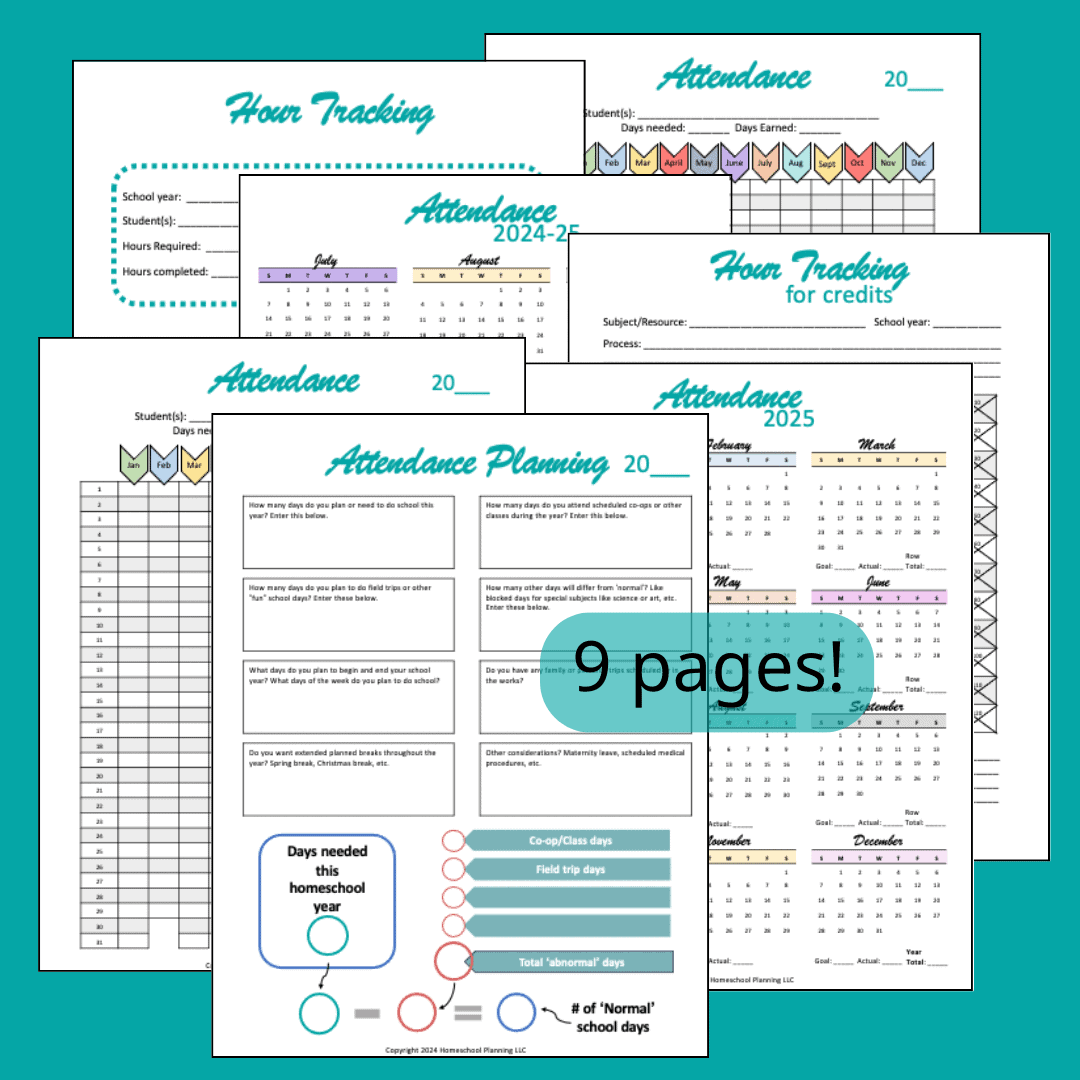
6. Homeschool curriculum breakdown
Break it down….dance party! Oh that’s not what it means? Well, you seriously deserve a dance break right now anyhow. So get up and jive then get back to it.
Now we’re going to take a look at the resources you have collected and figure out how each resource can be broken down into smaller bites. This is the next step in your homeschool plan.
Starting with the big picture, how do you want to approach the resources? Look at it in a realistic way alongside all the other things your child is doing.
Evaluate the difficulty level of it all together, how much parent involvement it needs and how you can approach that along with everything for each of your other kids.
Will you and your child be able to accomplish it all within the next year?
Practically speaking, I like to look at the chapters/lessons in each resource and break it down.
Like a workbook, I may look at the number of lessons or pages included, then divide by my number of weeks or school days planned. This will give me the number of pages to be accomplished each day or week.
Sometimes this number is not achievable, so perhaps you could consider (gasp!) not finishing the book in one year, or maybe even ever.
Many curricula are already arranged in 150-180 lessons or 32-36 weeks, which would be average lengths of a school year. I appreciate curricula at those lower numbers with some built in margin since we often get stuck on a lesson and take an extra couple days.
That also makes fitting in co-op or other outings into our schedule easier without deciding between math and fun or trying to do both in the same day. But of course sometimes you will have to be the flexible one.
Just remember it’s a tool, not a prison.
Focus on the big picture here. Just an overall view of the curriculum. Details will come and we’ll work on individual months, weeks, days, in a bit.

7. Homeschool planning hacks
There are a lot of brilliant homeschool planning hacks I’ve found in the homeschooling world.
Some resources may require a little more brain work if you want everything laid out in advance. Perhaps you find it hard to tackle each subject every day so you need another approach. Or maybe you just like to break up the monotony and switch things up occasionally.
For these situations, there are some interesting hacks you could use to make things a little more simple, organized and planned out.
Procedure Lists
Procedure lists are something I learned about form Pam Barnhill. I particularly use them for our history resources. This is just a list of the how will move through your history resources each day.
For example:
- Read the text
- Narrate what you learned
- Do the map work
- Do one activity
- Answer worksheet questions
Block schedules
If you hesitate with the mess of science experiments or art projects, you could create a block schedule. Block all your science days into a few weeks of the year or even just one dedicated day each week since it can be more involved.
You could block several subjects for that matter. Do history for 3 weeks, then science for 3 weeks. Then a lot of Language arts for 3 weeks. This can allow you to dig in deep to each project and topic.
Morning Time
Using a morning time in your homeschool plan can help greatly. In morning time, you can include many of the things you may want to do with all of your kids together. You can include several small or short items you may otherwise skip.
Read: Morning Basket Made Easy: Group Learning in Homeschool
Here’s a few items from our current morning time:
- reading a novel
- Bible study
- memorizing poems
- basic manners
Other items we have included at times in the past:
- music history
- music theory
- art history
- picture study
- mad libs
- reading poems.
But really, the sky is the limit. The hardest part for me is usually deciding what NOT to do. Ha!
Loop schedules
If you end up with several things in your morning time plans, including a loop schedule or bucket list may help keep things going smoothly.
This is basically a list of things you want to get through. But instead of doing them all each day, taking a lot of time, you can work through the list for 20 minutes or so.
Then the next day, pick up where you left off. Then you loop back to the beginning and start over. pretty revolutionary.
A bucket list is similar, but a little more complicated in that you loop through buckets daily. Within each bucket is another loop. Loops within loops. Complicated, but it can help you do all the things you are really wanting to do!
There are many options in how you approach your resources and the key is to find what works for your family.
“If you don’t know where you are going, you’ll end up someplace else.”
Yogi Berra
8. Homeschool schedules and routines
Now step 8 in your homeschool plan is the nitty gritty and where many of you will likely get hung up. Homeschool schedules.
I have included some great schedule worksheets for you in my basic homeschool planning printables. Download those today for free!
First, I have to say we are not trying to copy the public school system, so there is no need to feel like you need a detailed hour by hour schedule. If it helps you, great, do that.
But for most of us, I will venture to say it will not be helpful, because…life. Things come up.
Someone gets stuck on a math problem, you really are enjoying today’s read-aloud, the baby needs to nurse, grandma calls to chat, or any of the million things that seem to come up during a typical school day.
When I first was starting homeschooling, I came across a little ebook about scheduling that seriously changed my life. I couldn’t tell you the author at this point, but pretty sure it came from heaven.
It may sound silly but the idea was revolutionary to me. The main point was thinking about routines in your day rather than schedules.
So rather than putting time frames and limits on your day, just write out what you do in a general order.
You may put out a list of five things you want to accomplish before 9 am, but including general time frames rather than strict, will help many to not feel so restricted and always behind when something comes up.
If I build in flexibility and things come up, I don’t feel behind nearly as much or at all.
I also need to say to remember to be realistic here.
We’re not training soldiers going to battle tomorrow. We’re teaching our children how to learn and be functional adults.
The goal is not actually teaching them all the material in their math book. The goal is helping them to understand math so they can use it in life.
lt is not to teach them to read an entire book. It should be to enjoy reading so they can access the world of books on their own.
It’s not to learn the laws of nature, but to understand how the world interacts with us and to appreciate it.
It’s the journey, not the destination.
So try not to get bogged down by the schedule and tasks so much that you lose your focus. Help your kids learn and enjoy doing it together.
But since I’m a practical person, here are my suggestions. You may want to start by thinking about what your weeks and even days may generally look like with other activities or work you have happening included.
You can visualize this on a weekly calendar or just make a list like this:
- Breakfast
- Every weekday we do school in the morning.
- Coop on Mondays.
- Errands in the afternoon.
- Library trip on Tuesday afternoon.
- Chores
- Cook dinner
- Read
- Bed
That’s it. Unless you’re a very strict planner, try to stick to generalities and don’t tie yourself down to any sort of strict hourly schedule.
Specific hours are very flexible in my house. Times can even be added in later if it works for you, but there’s no reason to feel locked down before you even begin the school year.
Download my free homeschool planning pages to help you visualize your annual, weekly and daily schedules.

Stage 4: Organization
In the last stage of the planning process, you will organize everything and set yourself up for success for the year. From how you work through each day, to organizing the physical stuff. Tracking your days so you can easily have records ready by the end of the year.

9. Presentation
At the planning stage, presentation is the process of deciding on the various ways you will provide yourself and your children with daily materials.
Read: Organizing Daily Homeschool Work so Your Kids Know What to Do
I’m not talking here about a sixty slide Power Point presentation for your kids on all the things they will learn this year. Don’t get caught up on the title. This “presentation” doesn’t have to be fancy or formal in any way.
It often involves some sort of basic checklist.
Your presentation may already be quite straightforward, like for a computer-based curriculum.
Or you may have a resource or resources that includes a pre-planned schedule.
But if you are using several resources or designing your own curriculum and plans, this part may take more effort to figure out.
And even if you are using an all-in-one curriculum plan, you may also want to be sure your child completes other things within their day, like reading time or music practice, so using some sort of daily list may be helpful.
The way you approach your day will of course look different for each family.
For instance, I am one of those weirdos who at this point prefers to rip apart our various workbooks and give my children only the pages they need to do on any given day. It helps them focus and me to grade quickly.
In addition to doing this, I have developed a whole process that works for us with a pre-made chart listing out assignments for each subject.
Others may have all their workbooks kept bound in one place and will present the child with a checklist of work to accomplish each day that they make the night before.
Then others may prefer to keep the checklists to themselves and guide their child through the school day themselves. Or you may even work through the day without a written list at all.
Whatever you find works for you still has to be chosen and for some approaches requires a bit of prep work. Now is the time to get all that ready.
Some people will get their whole year all figured out in advance. But once again, hold that lightly if you do. Life happens quickly and plans need to change. Three-digit Multiplication can really throw off a plan I tell you.
And since you already have your general overview plan from step 6, doing this step should be fairly straightforward.
If you work on your planning in shorter time frames, you will likely be glad you did. So maybe write down your plan for a month or two then come back later, adjusting as needed. Many call this interval homeschool planning.
If even six weeks is a little too long for your more detailed plans, then this step can be done fairly quickly each Sunday, or even in your nightly prep time for the day ahead.
It can be done in a fancier way with a planner, spreadsheets and charts, or just a one dollar spiral notebook. You do you girl.
For more great info on this idea, check out my post 17 Ideas for Organizing Daily Homeschool Work so Your Kids Know What to do
“Our goals can only be reached through a vehicle of a plan, in which we must fervently believe, and upon which we must vigorously act. There is no other route to success.”
Pablo Picasso
10. Homeschool tracking
Tracking your homeschool day is just simply writing down what you and your child did for school that day, particularly academically. Coming up with a tracking system is the next step in your homeschool plan.
Read: Homeschool planning, tracking, and record-keeping: What’s the Difference?
This is not just tracking attendance, but also what you actually did each day.
This is, in my opinion, a vital step in homeschool planning and is what can save you future turmoil when it’s time to report what you’ve done.
Don’t fret, this step is simple!
It may be as easy as checking off the list of things you planned out in step 9. Or you may want to write down each thing after the fact. Easy peasy.
Some may argue that tracking what you do each day is unnecessary. That may be true. But I prefer to have all my bases covered. So in case there was ever a reason to know or prove what we have done and on what days, I will have that information readily available.
Still others will skip much of the planning in advance and only do the tracking. This worked well for me the first couple years of schooling as I was learning.
I’ve heard this called “planning from behind”. Just realize homeschool tracking isn’t planning. Homeschool plans are done in advance. Planning from behind is tracking. Record-keeping.
If you have a child that will be receiving letter grades and more official transcripts, this is a good time to also track grades for each assignment, test and project. Writing these things down as you go will save so much time at the end of the semester when you look back to gather and calculate final grades.

11. Homeschool records
Many times the homeschool records step is the only part of these homeschool planning steps that a parent ever does. And if you don’t prepare some in advance for this, boy can it take forever.
For a detailed discussion on this topic, check out my post: The Essential Guide to Record-Keeping for Homeschool
It can also be quite overwhelming, especially with older kids and their grades. I beg you, please have a good tracking plan in place. If you do, then homeschool reporting should be easy!
You could be one who lives in a state that doesn’t require reporting to anyone, and if so, I suggest you consider to go ahead and keep a good report anyway, even just for your own records.
It is important to know the requirements of your state for homeschoolers and to follow those laws so you can prevent future headaches.
Now what does a report entail? Traditionally, this is going to be a report card or transcript with each subject listed and the child’s earned grade next to it. There should also be a record for the number of school days attended.
If your child is in high school, the transcript should include a section for credits received.
For younger students, the earned grades may not be from a traditional letter grade scale but may be more of a subjective idea of how they did with the material. These may include grades like S for satisfactory, E for excellent, etc.
For older kids, or kids that excel with seeing letter grades, you will likely want to use a more structured grading system with a grading scale, weighting and rubrics along with other tools to calculate the grades and high school credits.
Read: The Essential Guide to Record-Keeping for Homeschool
Another part of homeschool reporting for your family may include a portfolio.
This can be look almost like a small resume, though not as formal. This may list things like extra-curriculurs, awards, accomplishments, service projects, and class descriptions, among other things, that were done during the year.
Many parents also like to store a sampling of work for each subject covered.
There are several options for keeping these homeschool records. There are a few online sites that are great for homeschool reporting and will even create professional looking transcripts.
You, of course, can make your own if you are so inclined or find a pre-made option you can print or buy.
And yes, colleges will accept home made transcripts!
I have created a great set of templates just for record-keeping. Download your set today!
“A man who does not plan long ahead will find trouble at his door.”
Confucius
12. Storage and supplies
This is the last step y’all! Hang in there just a bit longer.
The last thing to do in your homeschool planning is to gather all your books and supplies and figure out how and where to store them.
There really is no wrong way to do this. We usually end up at our dining room table for school, so I have set aside a couple shelves nearby for things we use often. We also have a rolling 3-tiered cart we use for other things we often use.
Books and things we don’t use as often are kept on our bookshelves in the play room.
I sometimes dream of a dedicated homeschool room but in our current house, we honestly wouldn’t use it much. We tend to congregate in one of the main areas of our home.
Other families purposely have a dedicated school room to prevent distraction from other things. All the books, supplies, and equipment are nearby and projects can be started there and left. If you have the ability to do this in your home, it may be a good option for you.
Though keep in mind, kids don’t need to sit at a desk to do their school work. Comfy living rooms can be just as worthy of being a schooling area as any amazing school room.
I’ve mentioned supplies a couple times here. So what is it that you need to actually homeschool? Well, you’ve already got the books and hopefully you have a good planner.
Beyond that, it’s mainly basic school supplies, art supplies, and a library card.
Read: 11 Simple Steps to Organizing Homeschool supplies
If anything extra is needed, most curricula will have a materials list included. So I highly suggest gathering as much of that as possible now so you aren’t running around like a mad woman the morning you were planning on doing the science experiment.
Speaking of science, many of the homeschool science curricula have supply kits you can buy online. Check them out, most of the time it’s worth the money to buy it in advance.
Here are some things I keep nearby in our school area:
- Workbooks
- Teacher books
- Readers
- Science books
- Science equipment and supplies
- Basic school and art supplies (scissors, hole punch, tape, glue, stapler, pencils, pens, erasers, paints, etc.)
- Paper of all kinds
- Math manipulatives
- Library books
- Printer
Need more ideas on getting your homeschool stuff organized? Check out my post 11 Homeschooling Organization Tips for the Unorganized
“Someone’s sitting in the shade today because someone planted a tree a long time ago.”
Warren Buffett
Wrap it up
Alright! You did it! I’m proud of you for getting to this point. Now you have a solid homeschool plan and I hope you feel like you can tackle this school year. Y
ou should have a great vision for what you want the school year to look like, the tools you need to make it happen and all the plans broken down into approachable pieces by quarter, month, day, maybe even to the hour. You even have a plan for tracking, storing, and reporting just for funsies.
Remember, this homeschool plan should always be revamped and revisited and never should feel like a prison. Take each day as it comes and try to be flexible.
Homeschooling isn’t about doing it all – it’s about your kids. Over all things, allow yourself grace to follow where life – and your kids – takes you. You’ve got this!
Related Posts
How to do a mid-year review of your homeschool
The best digital homeschool planners
Paper planners for homeschoolers
7 Steps for a simple homeschool plan
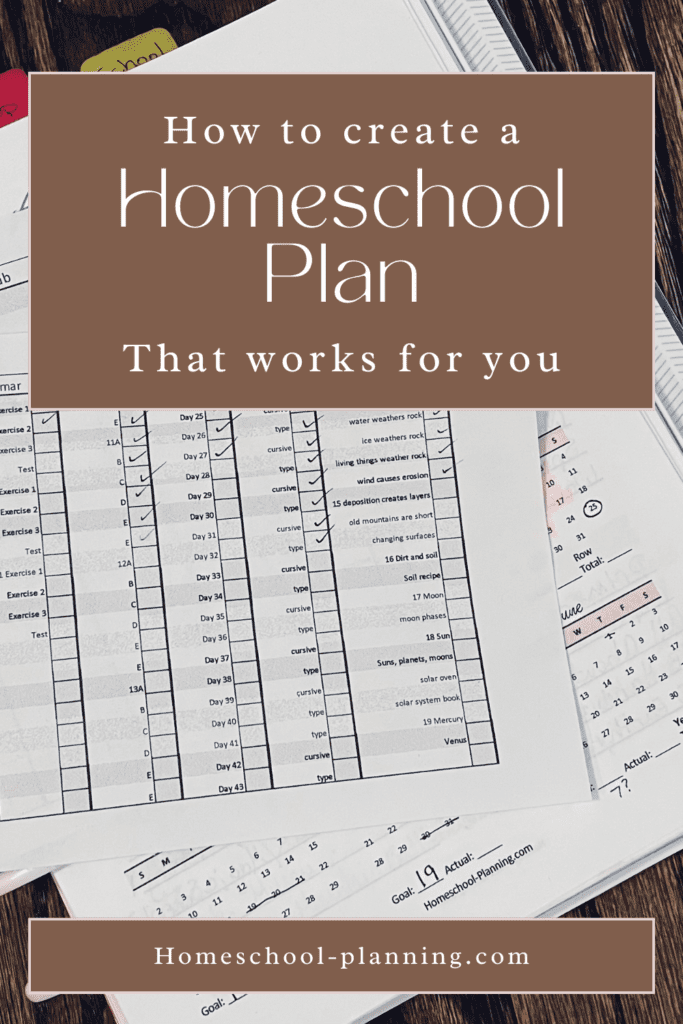
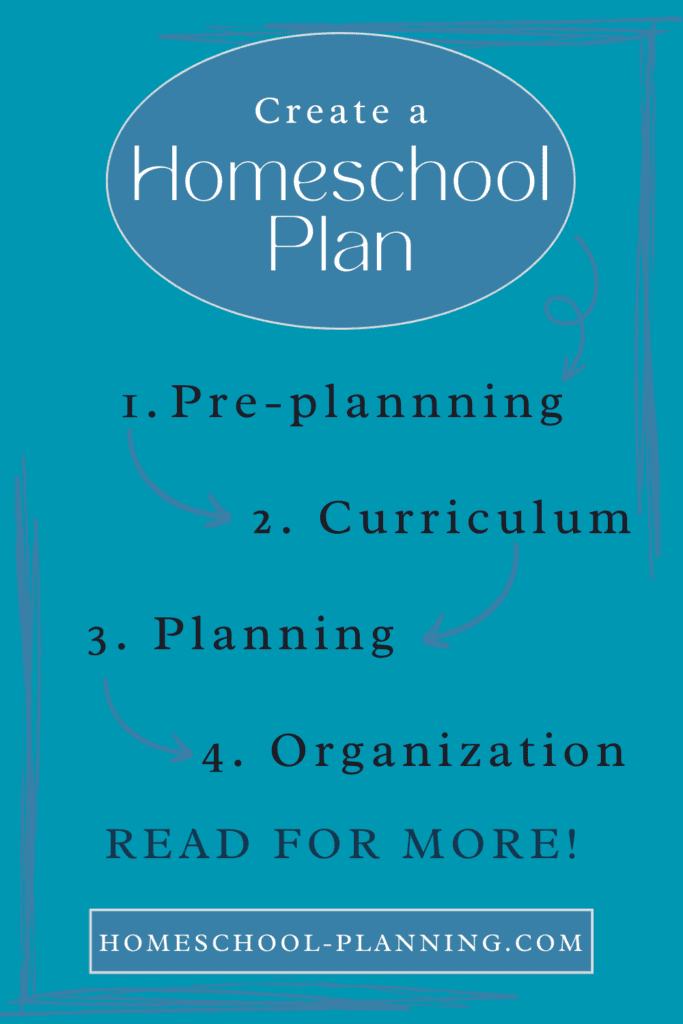












Pingback: How to Finish Strong this Homeschool Year - Homeschool Planning
Pingback: How to Create a Homeschool Plan in 7 Simple Steps - Homeschool Planning
Pingback: 8 Secrets to Simplify Your Homeschool Day - Homeschool Planning
Pingback: The Best Resources for Creating a Homeschool Booklist - Homeschool Planning
Thank You So Much! I enjoyed reading and learned a lot. All the stress for planning another year, this time with two has went out the window. I hope you have a wonderful and blessed school year.
I’m SO glad you’ve found it helpful! Have a wonderful year as well!
Pingback: Destroying our Homeschooling Box - Homeschool Planning
Pingback: 7 Hacks for Your Homeschool Schedule to Save Your Sanity - Homeschool Planning
Pingback: 7 Ideas to Make Homeschool Planning Time Less Terrible - Homeschool Planning
Pingback: Why You Should Do a Mid-Year Review of Your Homeschool (and How!) - Homeschool Planning
Pingback: Homeschooling After a Break: 13 Tips for Easing Back In - Homeschool Planning